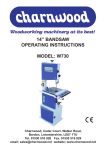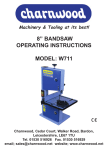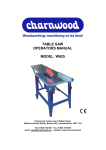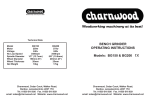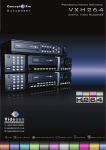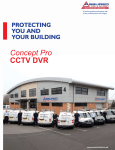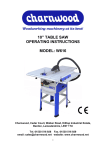Download Charnwood W619 Operating instructions
Transcript
8” TABLE SAW OPERATING INSTRUCTIONS MODEL: W619 Charnwood, Cedar Court, Walker Road, Bardon, Leicestershire, LE67 1TU Tel. 01530 516 926 Fax. 01530 516 929 email; [email protected] website; www.charnwood.net GENERAL SAFETY RULES WARNING: Do not attempt to operate the machine until you have read thoroughly and understood completely all instructions, rules, etc. contained in this manual. Failure to comply may result in accidents involving fire, electric shock, or serious personal injury. Keep this owner's manual and review frequently for continuous safe operation. 1.Know your machine. For your own safety, read the owner's manual carefully. Learn its application and limitations, as well as specific potential hazards pertinent to this machine. 2.Make sure all tools are properly earthed. 3.Keep guards in place and in working order. If a guard must be removed for maintenance or cleaning, make sure it is properly replaced before using the machine again. 4.Remove adjusting keys and spanners. Form a habit of checking to see that the keys and adjusting spanners are removed from the machine before switched it on. 5.Keep your work area clean. Cluttered areas and workbenches increase the chance of an accident.' 6.Do not use in dangerous environments. Do not use power tools in damp or wet locations, or expose them to rain. Keep work areas well illuminated. 7.Keep children away. All visitors should be kept a safe distance 8.from the work area. 9.Make workshop childproof. Use padlocks, master switches remove starter keys. and 10.Do not force the machine. It will do the job better and be safer at the rate for which it is designed. 11.Use the right tools. Do not force the machine or attachments to do a job for which they are not designed. Contact the manufacturer or distributor if there is any question about the machine's suitability for a particular task. 2 12.Wear proper apparel. Avoid loose clothing, gloves, ties, rings, bracelets, and jewellery which could get caught in moving parts. Non-slip footwear is recommended. Wear protective hair covering to contain long hair. 13.Always use safety glasses. Normal spectacles only have impact resistant lenses. They are not safety glasses. 14.Do not over-reach. Keep proper footing and balance at all times. 15.Maintain the machine in good condition. Keep the machine clean for best and safest performance. Follow instructions for lubrication and changing accessories. 16.Disconnect the machine from power source before servicing and when changing the blade. 17.Never leave the machine running unattended. Turn the power off. Do not leave the machine until it comes to a complete stop. 18.Do not use any power tools while under the effects of drugs, alcohol or medication. 19.Always wear a face or dust mask if operation creates a lot of dust and/or chips. Always operate the tool in a well ventilated area and provide for proper dust removal. Use a suitable dust extractor. ADDITIONAL RULES FOR CIRCULAR SAWS 1.Ensure that the saw table is clear of off-cuts, tools or anything else that might foul the work-piece. 2.If your saw has a dust extractor hose connected to the crown guard, ensure that it is held clear of the table and will not foul the work-piece as it passes over the table. 3.When cutting large sheets of material or long boards use one or more roller stand(s) to support the work or have a competent helper to support it as it feeds off the rear of the table. 4.Never use the saw without the riving knife and check that it is in line with the blade before using the saw. 5.Always use a brush to clear the table of dust or debris. NEVER use your hands, especially when the machine is running. 3 6.ALWAYS USE A PUSH STICK WHEN IT IS NECESSARY TO PUSH ANY PIECE OF MATERIAL OF SUCH SIZE THAT IT WOULD BRING YOUR HANDS WITHIN 30 CM OF THE BLADE. 7.Do not cut material that is badly warped or which has screws or nails in it 8.Be extra vigilant when cutting stock which has loose knots in it as these my fly out of the saw. 9.NEVER remove the table insert when the saw is running. 10.To avoid exposure to hazardous dust, do not use this saw without connecting it to a suitable dust extractor. 11.Always work with a sharp saw blade and feed the work at a rate suites to the thickness and hardness of the material. Note: This table saw has been designed and built solely as a woodworking machine. Do not modify it in any way or use for anything other than its designated purpose. Neither the manufactures nor the supplies are liable for any damage or injury caused by incorrect assembly, operation or electrical connection of this machine. Specification Table size 535 x400mm Table size with extensions 535 x 1000mm Motor 1100W, 240v single phase Blade diameter and bore 200mm 30mm Blade rotation speed (no load) 4700 rpm Maximum depth of cut at 90o 60mm Maximum depth of cut at 45o 40mm Cutting width with table extension 750mm Cutting width without table extension 150mm Dust extractor hose connection 100mm Weight 45kg 4 Features Precision ground, cast iron table Precision ground cast iron sliding carriage Adjustable guide hells on sliding carriage to ensure accurate travel 0 to 45o blade tilt Quick stop for 90o position of crosscut fence Dust extraction for crown guard as well as body of saw Adjustable feet for easy levelling Tungsten carbide tipped blade Unpacking Cut strapping and lift top and four sides of the crate off - all in one piece. Remove plastic bag, support the two black table extensions as you remove bag. They will not be damaged if they fall but they do make a loud noise! Pack 2 is a cardboard box which contains 5 aluminium extrusions and one nut and bolt. These latter are loose so make sure that you do not discard them with the packaging. Lay the saw over on its front and remove the two bolts holding it to the pallet. Support the bottom of the saw as you remove the second bold. There is little weight at this end of the saw, so one hand is adequate. Discard the pallet and remove from the interior of the saw base 2 flexible tubes, 3 jubilee clips, the crown guard, the tube support, the reducer and a bag of parts. 5 Assembly While the machine is on its side, take the four feet from the bag of parts and screw them into the four holes in the base. These feet can be adjusted by means of a spanner so that saw table is level after the machine has been put in place. Return the saw to a vertical position. The cast iron table is coated with a layer of grease to prevent rust. This is easily removed with a soft cloth moistened with paraffin or WD40. Warning Do not use petrol, thinners or paint stripper to remove grease as these substances may damage the paint finish. Raise the blade with the hand wheel at the front of the machine. Fit the handwheel from the bag of components to the spindle on the R/H side of the saw, tighten the grubscrew and turn the wheel until the blade is vertical Check that the riving knife is correctly aligned with the blade and then fit the crown guard to the top of it and tighten the self locking nut with a 10 mm socket (not supplied). There are two brackets at the front of the saw table and a similar pair at the back. Each one has two hex headed bolts and nuts passing through it and a small black adjuster at the back 6 Loosen the nuts and lifting each bolt head in turn, slide one of the two longest aluminium extrusions over them The extrusion with the scale should be fitted to the front of the table, scale uppermost and in both cases the wide groove should face outwards. If they are difficult to slide on, make sure that you have slackened the nuts sufficiently and rock the extrusions gently as you move them along. You may need to reach round to the back of the brackets and unscrew the black adjusters a little, if they are binding on the aluminium. Join the two parts of the rip fence using one cap head setscrew and one hex head bolt. Place it over the front guide rail. Align the fence with the saw blade and holding it in position, align the 0 on the scale with the left hand edge of the black portion of the fence. Having done this you can tighten up the nuts thus locking the guide rails in place. The small black adjusting screws are used to align the guide rails so that the rip fence is parallel with the blade no matter where it is along the length of the rail. 7 Now take the first of the extension tables, loosen the nuts and bolts and slide it onto the guide rails. Follow it with the second one and tighten all the locking nuts and bolts. If the tables do not slide into place easily, check that the front and back guide rails are really parallel and adjust the rear one if necessary. Do not move the front rail or you will upset the alignment of the rip fence. Fit the dust collection system. The bracket holding the plastic connector is fitted to the rear extrusion rail by sliding the bolt head into the extrusion. It can be positioned anywhere along the extrusion. A support arm is fitted into the top side of the extrusion. This holds the top hose out of the way during the cut. There are two hoses which are secured in place using the hose clamps supplied. Fit the two brackets which will carry the guide rail for the sliding carriage. These are bolted to the left hand side of the table with the setscrews provided. Leave them slightly loose until the guide rail is in place. Fit the guide rail in a similar way to that with which you attached the front and rear guide rails. Make sure that it is parallel to the saw blade Before fitting the sliding carriage it should be noted that the two outboard wheels are mounted on eccentrics. Their position can be adjusted with the aid of a 14 mm spanner. Slide the carriage on to the guide rail. Fit the front travel stop. This is the loose nut and bolt that that was in the cardboard box with the guide rails. 8 With the plastic end to the right, slide the two clamping block onto the crosscut/mitre fence. The Work clamp passes though its block and locates in the large hole at the front of the carriage. The block with the Kipp handle has its tee headed bolt slid into the keyway on the carriage. Fit the flip-over length stop Note: there is a push up stop at the left front corner of the sliding carriage. If you have set up the carriage guide rail correctly this will set the fence to give a 90o cut. Check all nuts and bolts for tightness. Using the Table Saw Rip fence Tilt adjustment wheel Tilt lock Depth of cut adjustment wheel NVR switch 9 Small cross cut and mitre fence. This may be used on either side of the blade. Adjustments to tilt and depth of cut should be made only when the saw is not running. Never force timber through the saw, always let it cut at its own speed. Always switch off and unplug the saw before removing or replacing the blade. Blade Removal and Replacement Remove the table insert by unscrewing the two black setscrews and lifting it off. Block the blade by fitting the special spanner supplied over the shoulders of the clamping washer. Unscrew the hex head bolt and remove the blade. Reverse this procedure to refit it. Troubleshooting Saw vibrates Check all nuts and bolts for tightness, check tilt is locked and check that blade is not damaged. Cuts are slow, wood is blackened Sharpen or replace blade. Saw stalls Feed rate too high, slow down. Tilt and/or blade height difficult to adjust Check tilt lock has been released, clean and lubricate mechanism. 10 PARTS DIAGRAM A 11 Circlip Rail support bracket Angle bracket 12 Eccentric nut Hand grip Plastic moulding Threaded spindle 13 Washer V belt Circlip Circlip Circlip Riving knife 14 Rubber washer Washer 15 L N Earth NVR switch 16

















